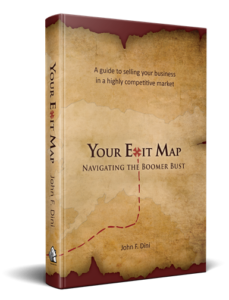There are four basics an owner should address before beginning any exit, succession, or transition plan. They are Valuation, Distance to Goal, Prospective Buyers, and Professional Team.
First, my apologies for missing a tri-weekly post. Between trips to Denver for BEI’s National Exit Planning Conference, Dallas for a client, San Antonio for our own XPX Exit Planning Summit, Nashville for the national EPI Exit Planning Summit, and St. Louis for Archford’s Metro Business Owner Summit, I kind of lost track of my posting schedule.
Here is the first of the four basic requirements. I promise not to dally in posting the rest of the full set.
Understanding Valuation
 Value is the starting point for all transition planning. Any decision, any business plan, and every retirement projection (either for time frames or finances) must start with the value of your business today.
Value is the starting point for all transition planning. Any decision, any business plan, and every retirement projection (either for time frames or finances) must start with the value of your business today.
Knowing the value of your business is different from thinking you know it. I talk to many owners who say “I met a guy at a trade show, and he told me that he knows a guy with a business just like mine who sold his company for five million dollars. I think I’m a little bigger than he was, so I know my business is worth at least six million.”
Sounds foolish? How about “My accountant says that all small business sells for about five times earnings.” Or “Everyone in my industry knows that all companies like ours sell for one and a half times revenue.”
Any valuation estimate that is in the same sentence as “all,” or “everyone” is a crock. Multiples may serve as guidelines, but the value of a specific business is always unique to that business.
How much is a manufacturer of disposable paper products worth? What if they specialize in paper straws? How much does that value change every time McDonald’s or Southwest Airlines announces that they are switching to paper straws? How much is it worth if it is the last paper straw manufacturer in the USA (like Aardvark® Straws?) If you understand the value, your mental estimate should have changed with each sentence.
Every change in the above paragraph described an intangible. Events and market conditions are as important, or in some cases more important, than last year’s numbers. Valuation starts with profitability and cash flow, but the real price that someone will pay for a business lies in the intangibles.
Intangibles
There are scores of intangible factors affecting business value. Most are related to customers, employees, or systems. Ask yourself these questions (although there are many more.)
- Customers:
- Do you get more than 20% of your sales from one customer?
- Is your revenue recurring (by contract) or a series of one-time transactions?
- Is your value proposition more than just “good service?”
- Are steady or repeat customers increasing their purchases?
- Can you forecast their purchasing accurately?
- Employees:
- Do you have managers that can run the day to day operations without you?
- Are your key employees too close to retirement age?
- Is turnover too high, or nonexistent?
- Are important positions cross-trained via a formal process?
- Do you have non-competes and/or long term retention incentives?
- Systems
- How accurate is your budgeting when compared to historical reality?
- Are all processes documented and followed?
- Is equipment carefully maintained?
- Our proprietary systems and knowledge protected?
- Do you track the effectiveness of sales and advertising expenses?
All valuations begin with profitability and cash flow. Most business appraisals take at least a cursory look at a few of the intangibles listed above. Buyers, however, will look at all of these factors and more.
Understanding the four basics of exit planning starts with valuation. If you don’t know where you are, it’s tough to plan where you are going.
For over twenty years, business owners have asked me “What can I do to increase the value of my company?” My answer is always the same.
“Exactly what you should be doing to improve it every day.”
Do you think you know the value of your business? Try the “Sellers Sanity Check,” a free tool at YourExitMap.com
Invest 15 Minutes and take our FREE Exit Readiness Assessment. We do not request any confidential information.
John F. Dini develops transition and succession strategies that allow business owners to exit their companies on their own schedule, with the proceeds they seek and complete control over the process. He takes a coaching approach to client engagements, focusing on helping owners of companies with $1M to $250M in revenue achieve both their desired lifestyles and legacies
 If an outside buyer is financing the purchase, seller notes can be considered as part of a down payment, but any bank will require it to hold second priority to their loan. If the Small Business Administration is involved, they will usually demand that the seller assume some of the risk with a secondary loan. In an internal sale, that will be a requirement.
If an outside buyer is financing the purchase, seller notes can be considered as part of a down payment, but any bank will require it to hold second priority to their loan. If the Small Business Administration is involved, they will usually demand that the seller assume some of the risk with a secondary loan. In an internal sale, that will be a requirement. Service businesses where the middleman lends expertise (easily duplicated by Internet research) or access to vendors are feeling the crunch already. The warning bell is sounding for mortgage companies, real estate agents, insurance and benefit brokers, employment agencies, printers, publishers, and travel agents.
Service businesses where the middleman lends expertise (easily duplicated by Internet research) or access to vendors are feeling the crunch already. The warning bell is sounding for mortgage companies, real estate agents, insurance and benefit brokers, employment agencies, printers, publishers, and travel agents. That approach helped the company grow with a balanced customer base. BVA has a presence in food testing laboratories, water and wastewater plants and the Texas oil fields, rather than the typical dominance of doctors and hospitals for their type of business.
That approach helped the company grow with a balanced customer base. BVA has a presence in food testing laboratories, water and wastewater plants and the Texas oil fields, rather than the typical dominance of doctors and hospitals for their type of business.
 For many owners, their biggest concern in an exit plan is maintaining control. Whether they seek to sell to employees, family or a third-party, there is a fear that, once started, the process will have its own rules and momentum.
For many owners, their biggest concern in an exit plan is maintaining control. Whether they seek to sell to employees, family or a third-party, there is a fear that, once started, the process will have its own rules and momentum.